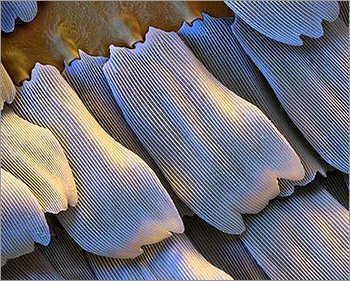*Inspired by Shane's Bumblebee "Random Thought"*
Might very well be common knowledge to some, but meh, we have enough "herbivorous pussy? What do i do?" threads ...
Bees attracted by floral iridescence

Iridescence is the optical phenomenon where a surface appears in different colors depending on the perspective (angle of incident light) of the observer, due to miniature structural features on the surface that scatter light.
Birds, fish, insects and reptiles use this for species recognition and mate selection.
Sometimes a hybrid color resulting from "chemical color" (pigments in material absorb all colors except a few, which give the apparent color) and structural color (iridescence)
Researchers at Bristol University in the UK have observed a species of bumble bee (Bombus terrestris) that's able to discriminate between chemical and structural color in hibiscus and tulip flowers.
Suggesting that iridescence as a communication mechanism in flowers and plants may be wide-spread and our ability to observe it, limited by our feature size resolution.
http://www.bristol.ac.uk/news/2009/6090.html
Might very well be common knowledge to some, but meh, we have enough "herbivorous pussy? What do i do?" threads ...
Bees attracted by floral iridescence
Iridescence is the optical phenomenon where a surface appears in different colors depending on the perspective (angle of incident light) of the observer, due to miniature structural features on the surface that scatter light.
Birds, fish, insects and reptiles use this for species recognition and mate selection.
Sometimes a hybrid color resulting from "chemical color" (pigments in material absorb all colors except a few, which give the apparent color) and structural color (iridescence)
Researchers at Bristol University in the UK have observed a species of bumble bee (Bombus terrestris) that's able to discriminate between chemical and structural color in hibiscus and tulip flowers.
Suggesting that iridescence as a communication mechanism in flowers and plants may be wide-spread and our ability to observe it, limited by our feature size resolution.
http://www.bristol.ac.uk/news/2009/6090.html








